It has some steps such as the first step is you should determine the number of zones and tubing loops. Then you should go for the installation process and in that stage, you need to have two tubes with a length of 2.5 feet. Also, you will need two slab risers with protective elbows for each loop. Also, you will need to shorten the length of the protective sleeve wherever control joints cross the tubing. Generally, protective sleeve comes in a ten feet coil.
And also you need to follow the below-given ways to configures manifolds such as single-zone manifold are always with multiple loops and multi-zone manifold want one loop per zone. So this is how you want to design a radiant floor heating system. Also, you can use engineering cad software for designing this system and may reduce your designing work.
What is the basic premise behind radiant floor heating?

First of all, people should know about what is the premise of radiant heating. The basic premise behind radiant heating is the warmth travels through hot-water tubes or electric wires that are fixed under the flooring in the home. The heat raises through the warms and the floor anything it comes in contact with them. Always the temperature of the air stays stable in the room and also there is no chance for heat is drawn from a person’s body when they contact the floor any longer. The reason for this change is radiant floor heating is more effective than the traditional forced-air system and the radiant heating temperature remains stable. Everyone has a more stable room temperature when the heating is coming from under the floor.
What are the types of floor heating available?
There are only two types of radiant heating available such as electrical and hot water. The principles for these both types are the same from beneath the flooring, but both are not using the same elements to maintain heat because each one using different elements for the heating process. In electrical radiant, there are zigzag loops of resistance wire that runs under the floor. In the hot water radiant system, half-inch of polyethylene tubes are carry hot water under the floor. And it will create the needed warmth in the room. Once you using any one of these types then you can cover it with tile or hardwood flooring.
How radiant heating works?
By heating the home from the bottom up, you have the same room temperature as you would with a forced-air system but the home can feel fully different. For example, the thermostat says seventy-two degrees of room temperature but it feels like eighty degrees, and others feel like sixty degrees. But in this radiant heating, a person’s feet and body feels the heat and it makes the room’s temperature seventy-two degree. The members in the home with forced air at set to seventy-two degree but it feels so cool because all the heat is rising to the ceiling and not they are low when it contact with them. One of the biggest advantages of this heating system is the person’s energy is saving. Their body will feel warmer at lower temperatures and allowing them to run the system less often. When their feet are warm, the other parts of the body begin to feel the same warmth even if the temperature is lower than they are used to. Their feet will be in contact with the warm floor and suddenly taking the chill out of their body on the cold mornings.




